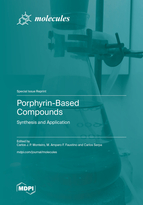Porphyrin-Based Compounds: Synthesis and Application
A special issue of Molecules (ISSN 1420-3049). This special issue belongs to the section "Organic Chemistry".
Deadline for manuscript submissions: closed (31 August 2023) | Viewed by 56886
Special Issue Editors
Interests: organic synthesis; fine chemistry; medicinal chemistry; pharmaceutical chemistry; drug development; porphyrin; photochemistry; photodynamic therapy; antimicrobial; leishmaniasis; neglected tropical diseases
Special Issues, Collections and Topics in MDPI journals
Interests: porphyrin derivatives and analogues; cyclo-addition reactions; photodynamic applications; DSSC cells; antimicrobials; antitumoral
Special Issues, Collections and Topics in MDPI journals
Interests: virus-host interactions; photo-responsive compounds; photodynamic therapy; biophysical analysis; spectroscopy; high-throughput screening
Special Issues, Collections and Topics in MDPI journals
Special Issue Information
Dear Colleagues,
Porphyrins, metalloporphyrins and their analogues, are a family of macrocycles that are ubiquitous in nature, playing key roles in numerous biological functions, such as in plant light-harvesting (e.g., chlorophyll, a magnesium–chlorin complex), oxygen binding and transport (e.g., heme group, an iron–porphyrin complex, responsible for animal cellular respiration), and bacteria photosynthesis. This refers to bacteriochlorophylls that occur in phototropic bacteria and enzyme-mediated catalysis (Cytochromes P450 enzymes that oxidize substances and metabolize a large variety of xenobiotic substances) or maintain healthy red blood cell formation (e.g., cyanocobalamin, a cobalt–corrin complex that acts as an enzyme co-factor in several biological pathways). Therefore, naturally occurring porphyrins are often called “the Pigments of Life”.
The pivotal functions played by these naturally occurring porphyrinoids have motivated and inspired organic chemists to produce synthetic porphyrins and analogues in the laboratory. The development of efficient synthetic methodologies to prepare porphyrinoids with new functionalities, electronic properties and photophysical features strongly encourages the application of these molecules in the medicine field (in photodynamic therapy of cancer, antimicrobial photodynamic inactivation, medical imaging and theragnostics) and as catalysts, receptors in sensors, and dyes for solar cells; in non-linear optics, molecular and supramolecular structures; and as components of materials and devices.
In the last few years, the multitude of porphyrin applications has transformed the interest in these compounds from purely academic to industrial processes. There is an increasing demand for the development of new synthetic processes involving sustainable chemistry principles avoiding dangerous solvents, reactants and excessive energy consumption. It is very relevant to implement new, more selective and efficient synthetic methods with a low environmental impact.
In this Special Issue, we invite original research papers and comprehensive reviews with a focus on the synthesis and functionalization of tetrapyrrolic macrocycles and their potential applications in different fields covering any aspect related to the abovementioned topics.
Dr. Carlos J. P. Monteiro
Dr. M. Amparo F. Faustino
Dr. Carlos Serpa
Guest Editors
Manuscript Submission Information
Manuscripts should be submitted online at www.mdpi.com by registering and logging in to this website. Once you are registered, click here to go to the submission form. Manuscripts can be submitted until the deadline. All submissions that pass pre-check are peer-reviewed. Accepted papers will be published continuously in the journal (as soon as accepted) and will be listed together on the special issue website. Research articles, review articles as well as short communications are invited. For planned papers, a title and short abstract (about 100 words) can be sent to the Editorial Office for announcement on this website.
Submitted manuscripts should not have been published previously, nor be under consideration for publication elsewhere (except conference proceedings papers). All manuscripts are thoroughly refereed through a single-blind peer-review process. A guide for authors and other relevant information for submission of manuscripts is available on the Instructions for Authors page. Molecules is an international peer-reviewed open access semimonthly journal published by MDPI.
Please visit the Instructions for Authors page before submitting a manuscript. The Article Processing Charge (APC) for publication in this open access journal is 2700 CHF (Swiss Francs). Submitted papers should be well formatted and use good English. Authors may use MDPI's English editing service prior to publication or during author revisions.
Keywords
- synthesis of porphyrins and derivatives
- functionalization/structural modification of porphyrinoids
- structural and photophysical characterization
- porphyrinic functional materials
- biomedical applications
- optoelectronic applications
- porphyrin–protein interactions
Benefits of Publishing in a Special Issue
- Ease of navigation: Grouping papers by topic helps scholars navigate broad scope journals more efficiently.
- Greater discoverability: Special Issues support the reach and impact of scientific research. Articles in Special Issues are more discoverable and cited more frequently.
- Expansion of research network: Special Issues facilitate connections among authors, fostering scientific collaborations.
- External promotion: Articles in Special Issues are often promoted through the journal's social media, increasing their visibility.
- Reprint: MDPI Books provides the opportunity to republish successful Special Issues in book format, both online and in print.
Further information on MDPI's Special Issue policies can be found here.









